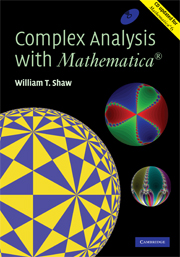Book contents
- Frontmatter
- Contents
- Preface
- 1 Why you need complex numbers
- 2 Complex algebra and geometry
- 3 Cubics, quartics and visualization of complex roots
- 4 Newton—Raphson iteration and complex fractals
- 5 A complex view of the real logistic map
- 6 The Mandelbrot set
- 7 Symmetric chaos in the complex plane
- 8 Complex functions
- 9 Sequences, series and power series
- 10 Complex differentiation
- 11 Paths and complex integration
- 12 Cauchy's theorem
- 13 Cauchy's integral formula and its remarkable consequences
- 14 Laurent series, zeroes, singularities and residues
- 15 Residue calculus: integration, summation and the argument principle
- 16 Conformal mapping I: simple mappings and Möbius transforms
- 17 Fourier transforms
- 18 Laplace transforms
- 19 Elementary applications to two-dimensional physics
- 20 Numerical transform techniques
- 21 Conformal mapping II: the Schwarz—Christoffel mapping
- 22 Tiling the Euclidean and hyperbolic planes
- 23 Physics in three and four dimensions I
- 24 Physics in three and four dimensions II
- Bibliograpy
- Index
15 - Residue calculus: integration, summation and the argument principle
Published online by Cambridge University Press: 05 August 2014
- Frontmatter
- Contents
- Preface
- 1 Why you need complex numbers
- 2 Complex algebra and geometry
- 3 Cubics, quartics and visualization of complex roots
- 4 Newton—Raphson iteration and complex fractals
- 5 A complex view of the real logistic map
- 6 The Mandelbrot set
- 7 Symmetric chaos in the complex plane
- 8 Complex functions
- 9 Sequences, series and power series
- 10 Complex differentiation
- 11 Paths and complex integration
- 12 Cauchy's theorem
- 13 Cauchy's integral formula and its remarkable consequences
- 14 Laurent series, zeroes, singularities and residues
- 15 Residue calculus: integration, summation and the argument principle
- 16 Conformal mapping I: simple mappings and Möbius transforms
- 17 Fourier transforms
- 18 Laplace transforms
- 19 Elementary applications to two-dimensional physics
- 20 Numerical transform techniques
- 21 Conformal mapping II: the Schwarz—Christoffel mapping
- 22 Tiling the Euclidean and hyperbolic planes
- 23 Physics in three and four dimensions I
- 24 Physics in three and four dimensions II
- Bibliograpy
- Index
Summary
Introduction
In this chapter we introduce the methods by which certain types of definite integral may be evaluated. Similar methods may be used to sum certain types of infinite series. The approach has many applications, and will be considered again in Chapter 16, in applications to Fourier transforms, and in Chapter 17, on Laplace transforms. We begin by establishing the Residue theorem, which relates a contour integral to the residues of the integrand at its various singularities. Then we explore how various types of real integral can be transformed into contour integrals, and then evaluated by an analysis of their singularities. Finally we take a brief look at the summation of series by residue methods.
Mathematica can play various roles in this part of the theory related to the evaluation of integrals by the calculus of residues. It can just be there to help with the algebra in calculating residues. You can use the functions Residue and NResidue to work out the residues directly. Finally you can use Integrate and NIntegrate to do a direct calculation of the answer. In this last case considerable care is required. The symbolic treatment of general integrals is an evolving (black) art and the results, mostly in the way they are displayed and the full details of conditions for the results to hold, will vary from version to version of the software. This matters particularly when the integrand contains parameters.
- Type
- Chapter
- Information
- Complex Analysis with MATHEMATICA® , pp. 302 - 337Publisher: Cambridge University PressPrint publication year: 2006



